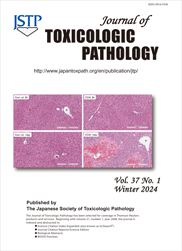
- |<
- <
- 1
- >
- >|
-
Takuma Yamamoto, Yuko Emoto, Takehiko Murase, Takahiro Umehara, Aya Mi ...2024Volume 37Issue 1 Pages 1-10
Published: 2024
Released on J-STAGE: January 16, 2024
Advance online publication: August 30, 2023JOURNAL OPEN ACCESSJapan has various death investigation systems; however, external examinations, postmortem computed tomography, macroscopic examinations, and microscopic examinations are performed regardless of the system used. These examinations can reveal morphological abnormalities, whereas the cause of death in cases with non-morphological abnormalities can be detected through additional examinations. Molecular autopsy and postmortem genetic analyses are important additional examinations. They are capable of detecting inherited arrhythmias or inherited metabolic diseases, which are representative non-morphological disorders that cause sudden death, especially in infants and young people. In this review, we introduce molecular autopsy reports from Japan and describe our experience with representative cases. The relationships between drug-related deaths and genetic variants are also reviewed. Based on the presented information, molecular autopsy is expected to be used as routine examinations in death investigations because they can provide information to save new lives.
View full abstractDownload PDF (741K)
-
Akiyoshi Nishikawa, Kasuke Nagano, Hajime Kojima, Shoji Fukushima, Kum ...2024Volume 37Issue 1 Pages 11-27
Published: 2024
Released on J-STAGE: January 16, 2024
Advance online publication: November 01, 2023JOURNAL OPEN ACCESS
Supplementary materialThe pathogenesis of nasal cavity tumors induced in rodents has been critically reviewed. Chemical substances that induce nasal cavity tumors in rats, mice, and hamsters were searched in the National Toxicology Program (NTP), International Agency for Research on Cancer (IARC), and Japan Bioassay Research Center (JBRC) databases, in addition to PubMed. Detailed data such as animal species, administration routes, and histopathological types were extracted for induced nasal cavity tumors. Data on non-neoplastic lesions were also extracted. The relationship between the tumor type and non-neoplastic lesions at equivalent sites was analyzed to evaluate tumor pathogenesis. Genotoxicity data were also analyzed. Squamous cell carcinoma was the most frequent lesion, regardless of the dosing route, and its precursor lesions were squamous metaplasia and/or respiratory epithelial hyperplasia, similar to squamous cell papilloma. The precursor lesions of adenocarcinoma, the second most frequent tumor type, were mainly olfactory epithelial hyperplasia, whereas those of adenoma were respiratory epithelial lesions. These pathways were consistent among species. Our results suggest that the responsible lesions may be commonly linked with chemically-induced cytotoxicity in each tumor type, irrespective of genotoxicity, and that the pathways may largely overlap between genotoxic and non-genotoxic carcinogens. These findings may support the documentation of adverse outcome pathways (AOPs), such as cytotoxicity, leading to nasal cavity tumors and the integrated approaches to testing and assessment (IATA) for non-genotoxic carcinogens.
View full abstractDownload PDF (1366K)
-
Hitoshi Kandori, Masami Aoki, Yumiko Miyamoto, Sayuri Nakamura, Ryosuk ...2024Volume 37Issue 1 Pages 29-37
Published: 2024
Released on J-STAGE: January 16, 2024
Advance online publication: October 27, 2023JOURNAL OPEN ACCESSThis study was conducted to visualize the lobular distribution of enhanced mRNA expression levels of heat shock proteins (HSPs) in liver samples from carbon tetra chloride (CCl4)-treated mice using in-situ hybridization (ISH). Male BALB/c mice given a single oral administration of CCl4 were euthanized 6 hours or 1 day after the administration (6 h or 1 day). Paraffin-embedded liver samples were obtained, ISH for HSPs was conducted, as well as hematoxylin-eosin staining and immunohistochemistry (IHC). At 6 h, centrilobular hepatocellular vacuolization was observed, and increased signals for Hspa1a, Hspa1b, and Grp78, which are HSPs, were noted in the centrilobular area using ISH. At 1 day, zonal hepatocellular necrosis was observed in the centrilobular area, but mRNA signal increases for HSPs were no longer observed there. Some discrepancies between ISH and IHC for HSPs were observed, and they might be partly caused by post-transcriptional gene regulation, including the ribosome quality control mechanisms. It is known that CCl4 damages centrilobular hepatocytes through metabolization by cytochrome P450, mainly located in the centrilobular region, and HSPs are induced under cellular stress. Therefore, our ISH results visualized increased mRNA expression levels of HSPs in the centrilobular hepatocytes of mice 6 hours after a single administration of CCl4 as a response to cellular stress, and it disappeared 1 day after the treatment when remarkable necrosis was observed there.
View full abstractDownload PDF (4148K)
-
Juan Li, Guojian Jiang, Jie Zhang, Zhuolin Ou, Xin Wu, Yueshu Liu2023Volume 37Issue 1 Pages 39-43
Published: 2023
Released on J-STAGE: January 16, 2024
Advance online publication: November 13, 2023JOURNAL OPEN ACCESSAmeloblastoma is a locally aggressive tumor derived from the odontogenic epithelium of the developing tooth germ. It is rarely reported in experimental Sprague-Dawley (SD) rats. In this 90-day percutaneous repeated-dose toxicity study, mandibular nodules were observed from day 56 to 90. Upon necropsy, a well-demarcated nodule, approximately 1.2×1.0×1.0 cm, was found attached to the mandibular bone, alongside the unerupted left incisor. Histopathologically, the epithelial cells formed islands, nests, or anastomosing strands. The epithelial islands were surrounded by a peripheral layer of tall columnar cells with antibasilar nuclei arranged in a palisading pattern. Several mitotic cells were observed. Some epithelial islands displayed cystic degenerative changes and squamous metaplasia. Necrotic tissue with inflammatory cell infiltration was observed at the tumor margins. Immunohistochemically, the neoplastic epithelial islands and mesenchymal components exhibited positivity for pan-cytokeratin and vimentin, respectively. Based on these features, the case was diagnosed as follicular ameloblastoma in an SD rat.
View full abstractDownload PDF (3782K)
- |<
- <
- 1
- >
- >|